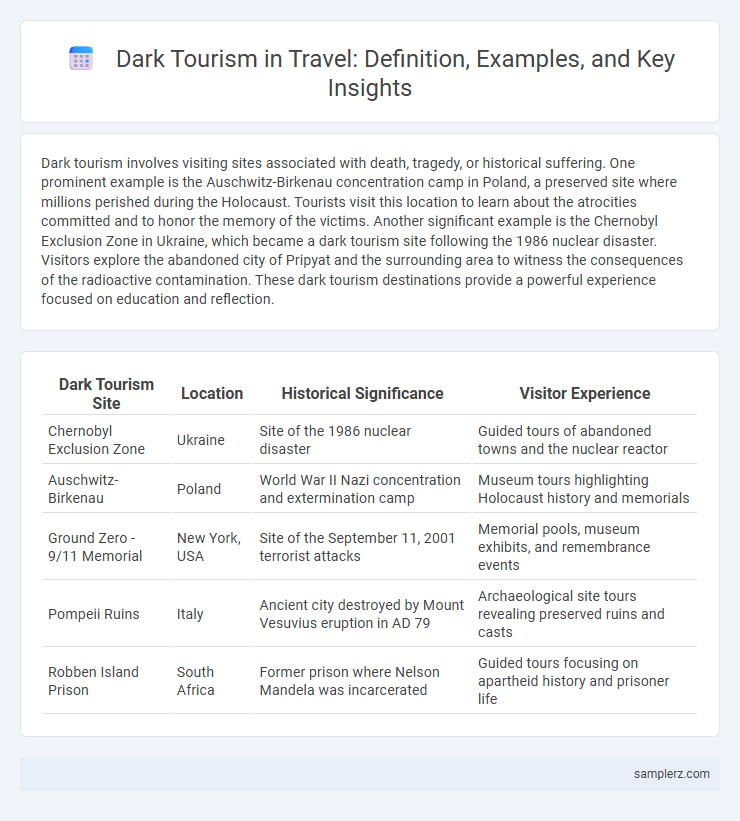Dark tourism involves visiting sites associated with death, tragedy, or historical suffering. One prominent example is the Auschwitz-Birkenau concentration camp in Poland, a preserved site where millions perished during the Holocaust. Tourists visit this location to learn about the atrocities committed and to honor the memory of the victims. Another significant example is the Chernobyl Exclusion Zone in Ukraine, which became a dark tourism site following the 1986 nuclear disaster. Visitors explore the abandoned city of Pripyat and the surrounding area to witness the consequences of the radioactive contamination. These dark tourism destinations provide a powerful experience focused on education and reflection.
Table of Comparison
| Dark Tourism Site | Location | Historical Significance | Visitor Experience |
|---|---|---|---|
| Chernobyl Exclusion Zone | Ukraine | Site of the 1986 nuclear disaster | Guided tours of abandoned towns and the nuclear reactor |
| Auschwitz-Birkenau | Poland | World War II Nazi concentration and extermination camp | Museum tours highlighting Holocaust history and memorials |
| Ground Zero - 9/11 Memorial | New York, USA | Site of the September 11, 2001 terrorist attacks | Memorial pools, museum exhibits, and remembrance events |
| Pompeii Ruins | Italy | Ancient city destroyed by Mount Vesuvius eruption in AD 79 | Archaeological site tours revealing preserved ruins and casts |
| Robben Island Prison | South Africa | Former prison where Nelson Mandela was incarcerated | Guided tours focusing on apartheid history and prisoner life |
Chilling Journeys: Introduction to Dark Tourism
Chilling journeys in dark tourism include visits to sites like Chernobyl, Auschwitz, and the Catacombs of Paris, where travelers explore the haunting remnants of history and human tragedy. These locations offer a profound exploration of historical atrocities, war, and disaster, providing an educational yet somber travel experience. Dark tourism emphasizes confronting past suffering, inviting reflection on events that shaped human resilience and collective memory.
Haunted Landmarks: Top Dark Tourism Destinations
Haunted landmarks like the Tower of London, Eastern State Penitentiary, and the Catacombs of Paris attract dark tourism enthusiasts seeking eerie historical experiences. These destinations offer rich narratives of ghostly legends, tragic events, and supernatural sightings that intrigue travelers worldwide. Visitors often participate in guided night tours and paranormal investigations, enhancing the immersive experience of dark tourism.
Historical Tragedies: Sites of Human Suffering
Historical tragedies attract dark tourism, with destinations like the Auschwitz-Birkenau concentration camp in Poland serving as stark reminders of the Holocaust's horrors. The Chernobyl Exclusion Zone in Ukraine draws visitors interested in the 1986 nuclear disaster and its long-term environmental impact. Sites such as the Hiroshima Peace Memorial in Japan provide powerful insight into the devastating effects of atomic warfare, emphasizing the importance of remembrance and education.
War Zones: Visiting Former Battlefields
Visiting former battlefields like Normandy's D-Day beaches in France or the Somme in Belgium offers travelers a poignant glimpse into war history and its lasting impact. Sites such as Gettysburg in the United States and the Cu Chi Tunnels in Vietnam provide immersive experiences that educate visitors about historical conflicts while honoring fallen soldiers. Dark tourism in war zones combines historical significance with somber reflection, drawing millions seeking deeper understanding of global conflicts.
Disaster Tourism: Exploring Natural and Man-Made Catastrophes
Disaster tourism attracts travelers to sites of natural catastrophes like the 2004 Indian Ocean tsunami in Thailand and man-made disasters such as Chernobyl in Ukraine, where visitors witness the aftermath and learn about the events. These locations offer poignant insights into human resilience and environmental impact while fueling local economies through educational tours. Dark tourism related to disasters emphasizes awareness and remembrance, often featuring guided experiences and museums dedicated to the tragedy's history and recovery efforts.
Macabre Museums: Exhibits of Death and Mourning
Dark tourism includes visits to macabre museums like the Museum of Death in Los Angeles, which displays artifacts related to serial killers and forensic pathology. The Capuchin Crypt in Rome features chapels decorated with human bones, illustrating historical practices of death and mourning. These sites attract travelers interested in the cultural and historical aspects of mortality and human rituals surrounding death.
Infamous Prisons: Tours of Notorious Correctional Facilities
Tours of notorious correctional facilities such as Alcatraz Island in San Francisco and the Kilmainham Gaol in Dublin offer travelers a unique glimpse into the harsh realities of incarceration and penal history. Visitors explore prison cells, solitary confinement rooms, and learn about infamous inmates, making these sites powerful examples of dark tourism. The immersive experience often includes guided narratives detailing historical events, prison escapes, and the socio-political impact of these penitentiaries.
Ghost Towns: Abandoned Places Frozen in Time
Ghost towns represent a unique facet of dark tourism, offering travelers a glimpse into abandoned places frozen in time, such as Bodie in California or Pripyat near Chernobyl. These eerie locales provide a haunting atmosphere where dilapidated buildings and deserted streets tell stories of former lives and disasters. Exploring ghost towns allows tourists to connect with history through a somber, immersive experience in places left untouched by modern development.
Ethical Considerations in Dark Tourism
Visiting sites such as the Chernobyl Exclusion Zone or the Auschwitz-Birkenau Memorial demands a careful balance between education and respect for victims. Ethical considerations in dark tourism emphasize preserving the dignity of those affected and avoiding commercialization or sensationalism of tragedy. Tour operators should prioritize informed consent, cultural sensitivity, and fostering awareness of historical context to ensure meaningful and responsible experiences.
Responsible Travel Tips for Dark Tourism Enthusiasts
Visiting sites such as the Chernobyl Exclusion Zone, Auschwitz-Birkenau, or the Hiroshima Peace Memorial demands respectful behavior, including adhering to local guidelines and avoiding disrespectful photography. Dark tourism enthusiasts should prioritize supporting local communities by using authorized guides and purchasing local services, ensuring economic benefits reach the area. Minimizing environmental impact and acknowledging the historical significance of these locations foster a more ethical and meaningful travel experience.

example of dark tourism in travel Infographic
 samplerz.com
samplerz.com